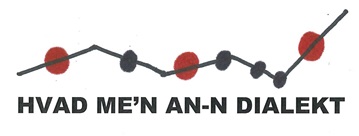How about another dialect?
In this section, we compare the questions from the overview section (Overview: Intonation in different question types) to the same questions spoken by a speaker of the same language but with a different variety.
Danish
The Copenhagen speakers, like the speaker in (50), keep the tone height of the accented syllables in their verbless questions at the same level all through the utterance (see Tonal movements with functions concerning the whole utterance). Since end-of-utterance tones are usually not used in Danish, this means that their utterances end somewhere in the middle of the speakers’ tone range.
(51) Copenhagen Danish

The question by the Jutland speaker in (51-1) also gives the impression of no big tonal movements and no declination through the utterance. This speaker tends to use rising tones on the accented syllables, which is typical of Jutland varieties, and the last one is not exaggerated in any way in comparison to the two previous ones:
(51-1) Jutland Danish

However, the second Jutland question is interesting, and therefore we present this here, too. This speaker also uses the Jutland rising accent melodies on the accented syllables; but the last syllable rises to a noticeably higher tone than the previous to accented syllables. This rise could be the result of emphasis, that is, the wish to highlight the word dialect more than the other words. But emphasis in the last word in Danish is rarely expressed by enhancing the tonal movements. The second alternative is that this is some kind of high end-of-utterance tone (see Tonal movements with utterance functions); and that is even more rare in Danish.
(51-2) Jutland Danish

Norwegian
For the verbless questions, the two Southeast Norwegian speakers use the verbless question format Hva med…? (“What with…?”), and the two South Norwegian speakers use the format Å med…? (“How with…?”).
Intonationally, it seems that Norwegian verbless questions can be pronounced in the same way as other questions, listen for example to the utterance in (52), which ends with an ordinary high, big accent 1 melody tone (also one of the South Norwegian speakers pronounces it in the same way).
(52) Southeast Norwegian

However, for what it is worth in such a small sample, we notice that those two Norwegian utterances that end with a clear separate, low end-of-utterance tone in our material belong to the verbless questions. In (52-1), the Southeast Norwegian speaker turns the high final big accent 1 tone on the last syllable (diaLEKT)-ter down again at the very end if the utterance, ending with a low end-of-utterance tone. Similarly, the South Norwegian in (52-1) also speaker also turns the tone of the last word of the generalizing tag o(g) sånn (“and such-things”) to a lower tone after the high final big accent 1 tone on o(g). However, it is at this point, with such a small sample, difficult to say if this has to do with the question type or with other communicative functions.
(52-1) Southeast Norwegian

(52-2) South Norwegian

Swedish
There is no comparison to the elliptical, verbless question was already presented in example (53) in the overview text. This was the only elliptical question found among the Swedish speakers. As for the second suggested elliptical question, the one about the use of robots in education, all four speakers reformulated it into normal question-word questions.
The utterance in (53) with its high end-of-utterance tone is repeated here for convenience:
(53) Central Swedish
